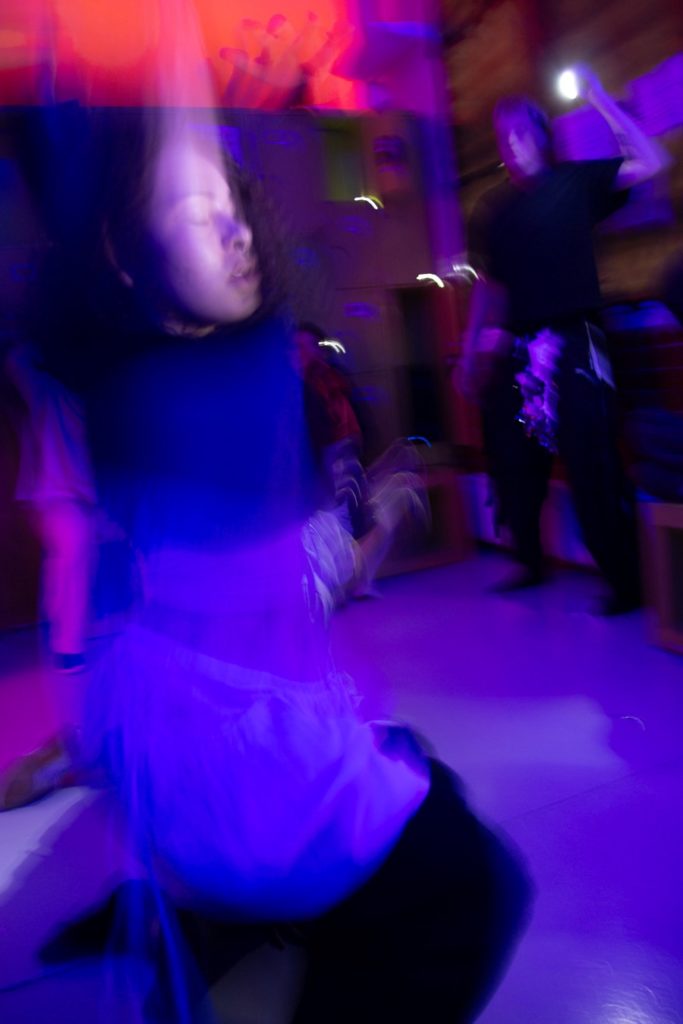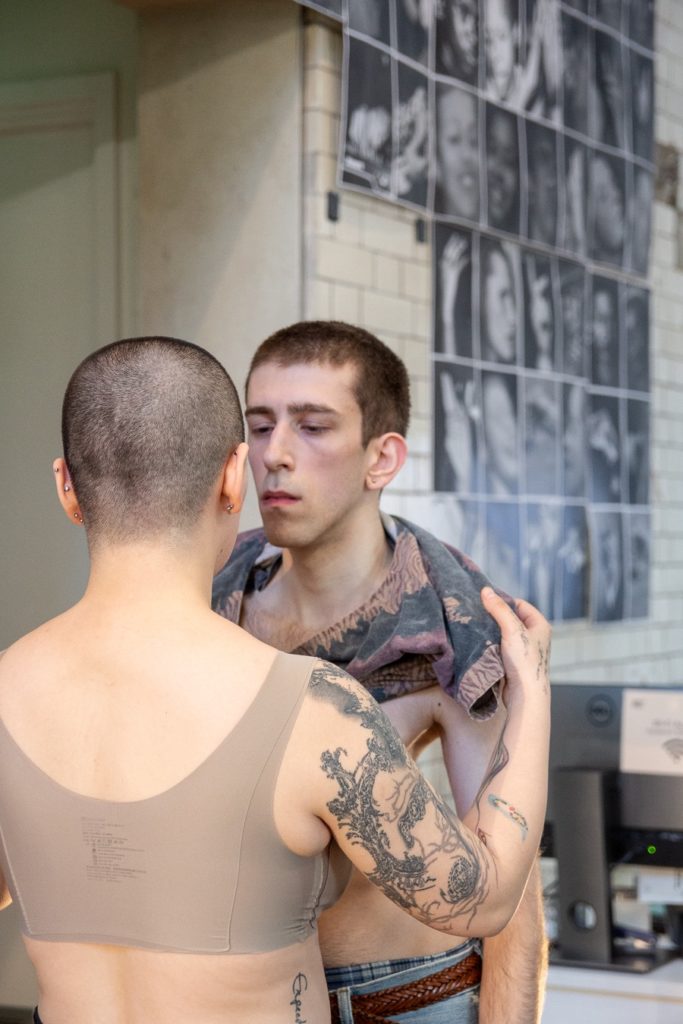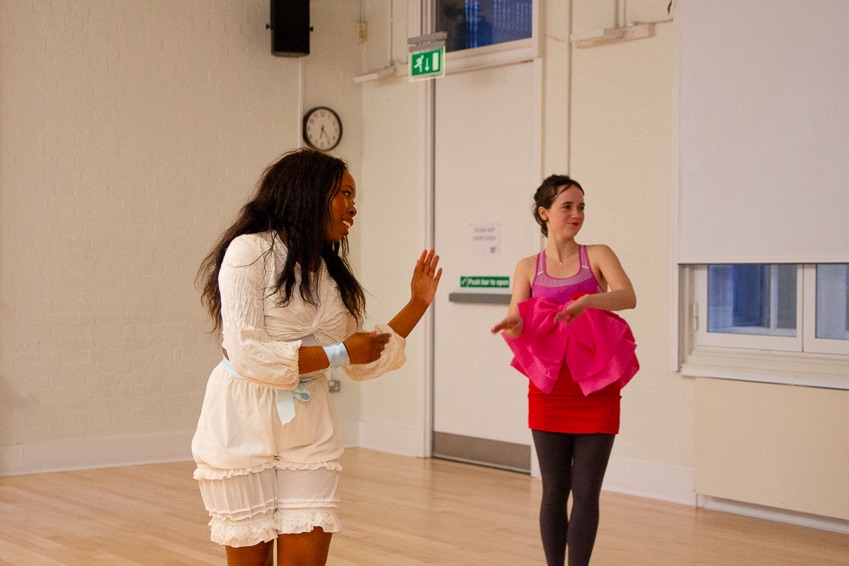Words by Francesca Matthys.
I had the pleasure of attending the Next Choreography Festival at Siobhan Davies Studios a couple of Saturdays ago. Joined by some of the DAJ gang, it felt like a treasure hunt following the provided map to discover what new choreographic gems we would discover next.
Community, Support, Radical Watching and Listening are themes that have marinated into my being after the evening together. Threaded not only through the performance content, but the way the artists collectively exist in the space. Even the sharing of dialogue waiting in line for a warm cooked meal felt a performative element itself. And concepts too. The conceptual nature of the works are what I continue to unpack as I write.
It feels quite appropriate to reflect on this experience from the end, as the final two works in the roof studio at Siobhan Davies Studios, Villagers by Rachel Coleman and You and I are Here a collaborative performance by Martha Harlan and the audience, encapsulate these ideas of togetherness that we were offered during the evening.
Villagers seemed to serve as a recurring motif throughout the evening. They are almost one body, one flesh, they are united in experiencing the space as they move through each other like sea anemone. They watch, they listen, they sincerely see each other and us. The final version of this is distilled and open, as Coleman dances with ease and play while the group holds space. It is a gentle offering and one we are pleased to be left with.
Just before this, Martha Harlan begins to run, run and fill the space with their perseverance. We the community are invited to support this motion in whichever way we choose and have capacity for. This invitation develops into a swarm of supporters holding space for Harlan to process, to feel, to try, to dare. This offering from Harlan urges me to think of what it means to create an accessible movement improvisational score that invites people in and assures them that it is okay to be themselves in whatever form they wish. Is this possible? What Harlan offers is a curious dialogue to be had on permission, permission to take agency within performance, especially in designated arts spaces. It is also a quiet revolution, a solidarity, a protest, an action. An illustration of how in these times we may share the load together.
We spent most of the evening searching the building, trying to see as much as possible. I enjoyed this active role of the audience. An opportunity to author how we experience art. My only wish is that we had more time. A whole day or weekend even to relish in this experience.
Along our trail though were more other works such as the The Changing Rooms by Aisha Kacie and Phoebe Beckett Chingono. This is a work that echoes the collective processing through the world of an underground rave club space. Many alternative club spaces today carry the intersection of politics, activism, self expression, queerness and art on their dance floors and this work is a reflection on the power of spaces to individually and collectively move through.
Words such as exiled, fumbling, persecution and displacement can be vaguely seen on the walls through the flashing embodied lights (dancing bodies directing our attention through flashlights). Perhaps we have been exiled into this club space? But what do we do here? How do we move forward? We are lucky to be here because here we can be ourselves. With organic movements, pulsing, leaning in and leaning out, this work is a strong and immersive beginning to something.

After, again choreographed by Kacie and Beckett Chingono and co-performed by Louie Thornton and Martha Harlan feels like an amplified expression of what has remained after The Changing Rooms. In rhythm, in pulse in ‘throwing away’ through the hands any remains of what may be holding them back from moving forward. This work illustrates the potential of their choreographic voices which is exciting for their collaboration.
Also in the roof studio and in Pater choreographer and performer Anna Nicholls is present and rooted, remembering and honouring their late father. The movement vocabulary that is playful and dynamic allows us to share in this celebration of life. 70s music echoes through the room as if we were watching an old film. Memories. Anna with their company Hallomai Dance are preparing an extended version of this new work which I look forward to witnessing.
Following this in the majestic and lowly lit roof studio is Mark Crawley’s work The (Very) Best Dancers in the World. I loved the way this work transformed the energy in the room. Illuminating it with a sensitive groove and attentiveness in the space and body, Crawley is easy to watch as they move through quirky melodic gestures, clowning and even lip-syncing. Their sincerity allows us to empathise and allow our inner child to vicariously live through this dance. The invitation of audience activation felt very integrated and necessary.
Coming down from the roof studio to the second floor, we spot City Life happening downstairs in the foyer by Billy Gigurtsis and co-performed by Lin Ji. They truly embody stillness and intimacy. They undress each other with the utmost of care. Their gazes are fixed on one another, holding space for one another’s vulnerability. This action, so slow and intentional, alerts us to the subtleties of being human, of connection and of the capacity to amplify heartbeat, breath, blinking of eyes, the sensation of cotton brushing between fingertips, closeness regardless of what may be happening around us.

Travelling around the building from earth to sky is also Maria Jablkowska as their unapologetic persona reminiscent of the ‘Mad Hatter’ character in The Tie She Wears. Jablkowska is like a guide, another present figure we become familiar with in the space both solo or tied to another at the neck by a tie. It is a provocative and political image that reminds me of 16th century witch hunts. Finally we see Jablkowska in the changing room liberating herself from all that she may be tied to. Her commitment to character is potent throughout. In the same vein of distinct performance personas and in conversation with The Tie She Wears, With Bows On by Lucy Mae Bean and Kabira Imona shifts from what we may usually expect from contemporary dance, referencing dances such as the Charleston, poetry and a song by Edith Piaf. Tied together by their bows, they are tied together by their need to perform and use their bodies as currency to please. With more development this could be an intriguing work by these two actors.

More works that were offered by these new choreographers were Warm Ups Ray Sims and performed by all NEXT participants, a Prophecy by Tasalla Tabasom, The Devil’s Grin by Zhuoyan Hu, Only to Breath the Moment by Kardelen Kutlu, Contact by Victoria Daniels, Fix this. Don’t, fix this by Louie Thornton and co-performed by Aisha Kacie, Martha Harlan and Phoebe Becket Chingono, unravelling, reravelling by Martha Kent and co-performed by Phoebe Beckett Chingono, Anna Nicholls, Maria Jablkowska, Billy Gigurtsis, Martha Harlan, Aisha Kacie, Ray Sims and Rachel Coleman, Body Doubles by Perpetua Png and co-performed by Yingtong Lin and Anna Nicholls and Asymmetry by Dominic Bruce-Radcliffe and Tasalla Tabasom.
The collaborative effort and sincere care and openness to each other’s creativity is evident in this collective. What a wonderful opportunity to not only continue discovering the creative potential of the individual but also the group. ’Freedom for the individual comes from unity of the group’ a strong sentiment left on the walls of the changing room. If this is the next generation of young choreographers, we can certainly say that they will be more than alright!
This article was commissioned by SDS.
